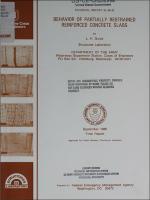Please use this identifier to cite or link to this item:
https://hdl.handle.net/11681/11287| Title: | Behavior of partially restrained reinforced concrete slabs |
| Authors: | United States. Federal Emergency Management Agency Guice, Leslie K. |
| Keywords: | Blast effects Explosion effects Concrete slabs Reinforced concrete construction Materials Dynamic testing Concrete strength Keyworker blast shelters Underground structures Buried structures |
| Publisher: | Structures Laboratory (U.S.) Engineer Research and Development Center (U.S.) |
| Series/Report no.: | Technical report (U.S. Army Engineer Waterways Experiment Station) ; SL-86-32. |
| Description: | Technical Report Abstract: This study was performed in conjunction with a Federal Emergency Management Agency program to plan, design, and construct Keyworker blast shelters. Keyworker shelters are box-type shelters in which damage is more likely in the roof-slab than in the walls or floor. This study investigates the effect of partial edge restraint on the strength, ductility, and failure mechanisms of a slab. Sixteen one-way, reinforced concrete plate elements were tested in a specially designed reaction structure under uniform static water pressure. Facilities were designed and constructed to measure the slab end actions, including thrusts, moments, and rotations. The primary parameters investigated included the span-thickness ratio, reinforcement ratio, and degree of edge restraint. Most slabs were loaded until significant tensile membrane forces developed. Rotational restraint significantly influenced overall slab behavior. If a slab is to develop significant compressive membrane forces, both lateral and rotational restraint must be provided. Small rotational freedoms had a relatively small effect on the slab's compressive membrane response. With large rotational freedoms, however, the slabs generally snapped through to the tensile membrane stage before significant thrusts were developed. Thin slabs generally exhibited a much better tensile membrane response than thicker slabs and underwent larger deflections before collapse. Recommendations are presented and an analytical procedure which considers nonlinear geometric behavior is proposed for investigating total slab response. NOTE: This file is large. Allow your browser several minutes to download the file. |
| Rights: | Approved for public release; distribution is unlimited. |
| URI: | http://hdl.handle.net/11681/11287 |
| Appears in Collections: | Technical Report |
Files in This Item:
| File | Description | Size | Format | |
|---|---|---|---|---|
| TR-SL-86-32.pdf | 29.04 MB | Adobe PDF |  View/Open |